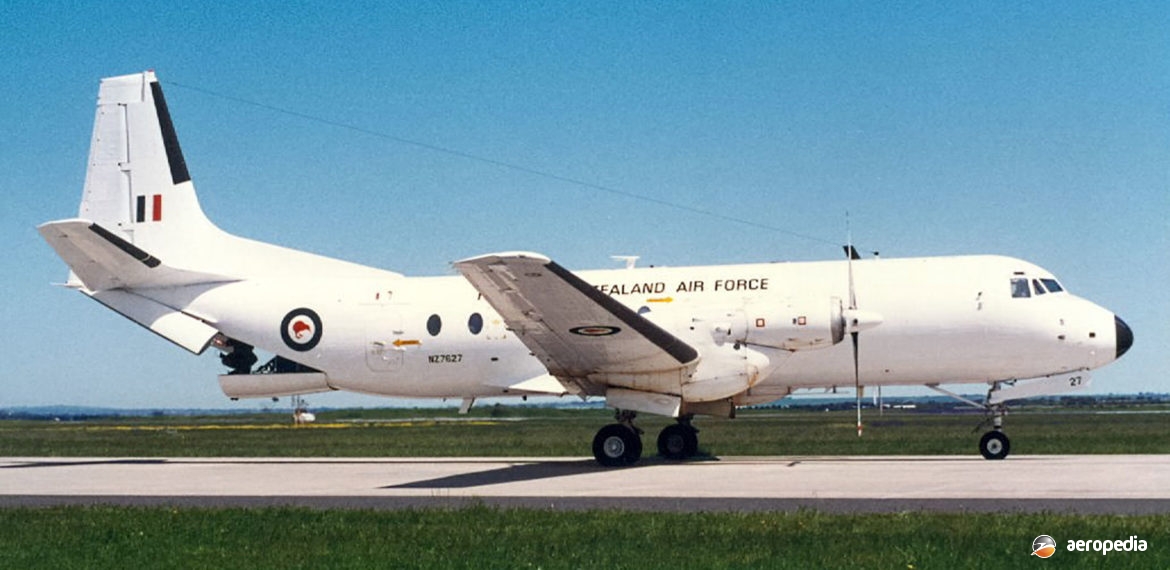Photograph:
RNZAF Hawker Siddeley Andover NZ7627 at Avalon, VIC in October 1992 (David C Eyre)
Country of origin:
United Kingdom
Description:
Military tactical transport
Power Plant:
Two 2,214 kw (2,970 shp) Rolls Royce Dart RDa 12 Mk 201 turboprops
Specifications:
- Wingspan: 29.92 m (98 ft)
- Length: 23.75 m (77 ft 1 in)
- Height: 9.15 m (30 ft 1 in)
- Wing area: 77.2 m² (831 sq ft)
- Cruising speed at 6,095 m (20,000 ft): 415 km/h (258 mph)
- Max rate of climb at sea level: 357 m/min (1,170 ft/min)
- Service ceiling: 7,315 m (24,000 ft)
- Take-off distance over 15 m (50 ft) obstacle: 369 m (1,300 ft)
- Landing distance overf 15 m (50 ft) obstacle: 369 m (1,300 ft)
- Range with max payload: 500 km (311 miles)
- Range with max fuel: 1,865 km (1,158 miles)
- Fuel capacity: 6,550 litres (1,441 Imp gals)
- Provision for auxiliary fuselage tanks with capacity of 7,728 litres: (1,700 Imp gals)
- Empty weight: 12,569 kg (27,709 lb)
- Max payload weight: 6,691 kg (14,750 lb)
- Loaded weight: 22,680 kg (50,000 lb)
History:
During the early 1960s the Royal Air Force (RAF) issued a requirement for a medium tactical freighter, and the Avro design team developed a variant of the Avro 748 (later Hawker Siddeley 748 Series 2). The low wing layout was retained but the rear fuselage was swept up to incorporate a rear loading ramp with doors capable of opening in flight. Major modifications were made to the airframe to suit its military use, and the tailplane was relocated to the base of the fin and given a dihedral. The undercarriage was re-designed to permit it to ‘kneel’ so it could be adjusted to raise or lower the height of the cabin floor for loading or unloading. In addition, more powerful Rolls Royce Dart engines were installed.
The Andover could carry a variety of loads, including 56 to 58 troops; 40 paratroops and despatchers; 24 stretcher patients and attendants; three Land Rovers; or 6,936 kg (15,350 lb) of freight. In all, 31 Andovers were built for the RAF’s Air Support Command. It was popular with crews and served in the United Kingdom, Singapore and Aden. The large wingspan and turboprop engines gave the aircraft good field performance, being able to carry bulky and outsize loads.
The prototype, which was converted from an HS.748, was flown on 21 December 1963 and the first batch produced was known as the Mk 1. Included in this batch were two CC.2s, which were operated by the Queen’s Flight. Subsequently the Series 2 and Series 2A were produced, having more powerful Dart engines. The prototype Series 2A was later converted to Coastguarder configuration, flying for the first time on 18 February 1977. This model had a wet-wing, facility for search-and-rescue, and a chute to eject five-man dinghies.
Following the withdrawal of RAF forces west of the Suez in the 1975 Defence Cuts, the RAF was reduced to one squadron equipped with the Andover and, as noted below, ten were transferred to the Royal New Zealand Air Force (RNZAF), five were relegated to ground training duties, and four were deployed to RAF Germany for communications use. Three went to the Ministry of Defence Procurement Executive and six to No 115 Squadron, being used for calibration duties. One spent a little time with No 51 Squadron, the RAF’s ELINT unit. A few were converted for other duties, four having lights mounted in the nose for calibration of instrument landing system (ILS) equipment becoming known as the E.Mk 3; and a few were attached to No 32 Squadron for communications work in 1992. Two went to No 60 Squadron and were fitted with cameras for reconnaissance work, becoming the C.1(PR) . The type ended its service with No 32 Squadron at Northolt in west London and one operated with the Defence Research Agency at Bedford in Bedfordshire.
As noted, in 1976 the RNZAF obtained ten Andovers from the RAF to replace the Bristol 170 Mk 31 Freighters, these becoming NZ7620 (c/n 6 – ex XS599); NZ7621 ( c/n 7 – ex XS600); NZ7622 ( c/n 9 – ex XS602); NZ7623 (c/n 11 – ex XS604); NZ7624 (c/n 15 – ex XS608); NZ7625 (c/n 18 – ex XS611); NZ7626 (c/n 19 – ex XS612); NZ7627 (c/n 20 – ex XS613); NZ7628 (c/n 22 – ex XS638); and NZ7629 (c/n 29 – ex XS645).
A number were used by No 1 Squadron (based at Whenuapai) in the short / medium-range tactical transport role of troop lift, casualty evacuation, paratrooping, and paradropping of supplies, but this squadron was disbanded in December 1984.
No 42 Squadron (based at Ohakea) also took delivery of a number for VIP and general communications duties, two aircraft being fitted out for VIP duties. In December 1984 No 42 Squadron moved to Whenuapai and took over the duties previously performed by No 1 Squadron.
In 1998-1999 the type was withdrawn from service and most were sold to civil operators overseas, one NZ7621 (c/n 7 – ex XS600) being retained for the RNZAF Museum at Wigram, and another (NZ7624) being used by the RNZAF at Whenuapai for fire drill. The main problem the aircraft had in RNZAF service was the aircraft’s limited range with a reasonable load, particularly when they were initially obtained to replace the Bristol 170 Freighter which had an even more limited range.
A number of ex-RNZAF Andovers were acquired by Eureka Aviation which registered them in Zaire where they took up duties in both passenger and cargo roles.

